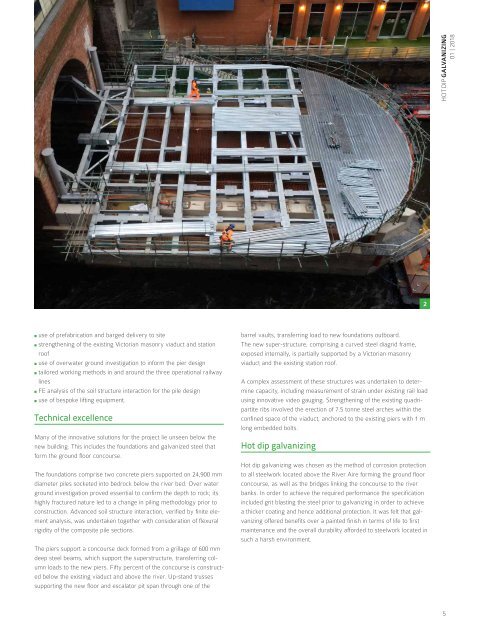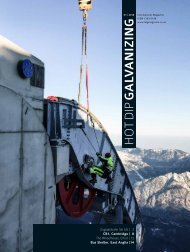HDG Magazine Issue 1 2018
Create successful ePaper yourself
Turn your PDF publications into a flip-book with our unique Google optimized e-Paper software.
HOT DIP GALVANIZING<br />
01 | <strong>2018</strong><br />
2<br />
use of prefabrication and barged delivery to site<br />
strengthening of the existing Victorian masonry viaduct and station<br />
roof<br />
use of overwater ground investigation to inform the pier design<br />
tailored working methods in and around the three operational railway<br />
lines<br />
FE analysis of the soil structure interaction for the pile design<br />
use of bespoke lifting equipment.<br />
Technical excellence<br />
Many of the innovative solutions for the project lie unseen below the<br />
new building. This includes the foundations and galvanized steel that<br />
form the ground floor concourse.<br />
The foundations comprise two concrete piers supported on 24,900 mm<br />
diameter piles socketed into bedrock below the river bed. Over water<br />
ground investigation proved essential to confirm the depth to rock; its<br />
highly fractured nature led to a change in piling methodology prior to<br />
construction. Advanced soil structure interaction, verified by finite element<br />
analysis, was undertaken together with consideration of flexural<br />
rigidity of the composite pile sections.<br />
The piers support a concourse deck formed from a grillage of 600 mm<br />
deep steel beams, which support the superstructure, transferring column<br />
loads to the new piers. Fifty percent of the concourse is constructed<br />
below the existing viaduct and above the river. Up-stand trusses<br />
supporting the new floor and escalator pit span through one of the<br />
barrel vaults, transferring load to new foundations outboard.<br />
The new super-structure, comprising a curved steel diagrid frame,<br />
exposed internally, is partially supported by a Victorian masonry<br />
viaduct and the existing station roof.<br />
A complex assessment of these structures was undertaken to determine<br />
capacity, including measurement of strain under existing rail load<br />
using innovative video gauging. Strengthening of the existing quadripartite<br />
ribs involved the erection of 7.5 tonne steel arches within the<br />
confined space of the viaduct, anchored to the existing piers with 1 m<br />
long embedded bolts.<br />
Hot dip galvanizing<br />
Hot dip galvanizing was chosen as the method of corrosion protection<br />
to all steelwork located above the River Aire forming the ground floor<br />
concourse, as well as the bridges linking the concourse to the river<br />
banks. In order to achieve the required performance the specification<br />
included grit blasting the steel prior to galvanizing in order to achieve<br />
a thicker coating and hence additional protection. It was felt that galvanizing<br />
offered benefits over a painted finish in terms of life to first<br />
maintenance and the overall durability afforded to steelwork located in<br />
such a harsh environment.<br />
5



